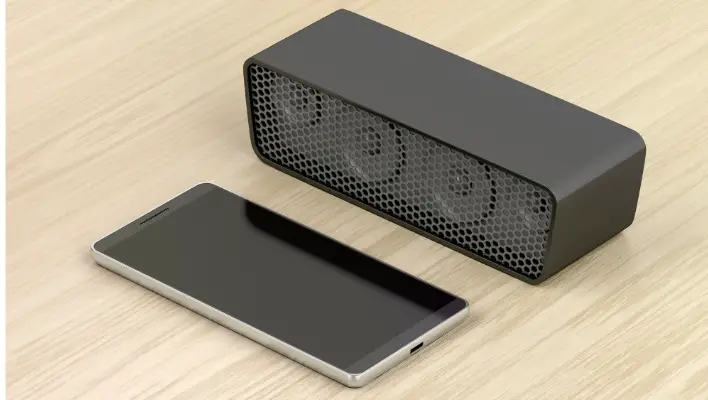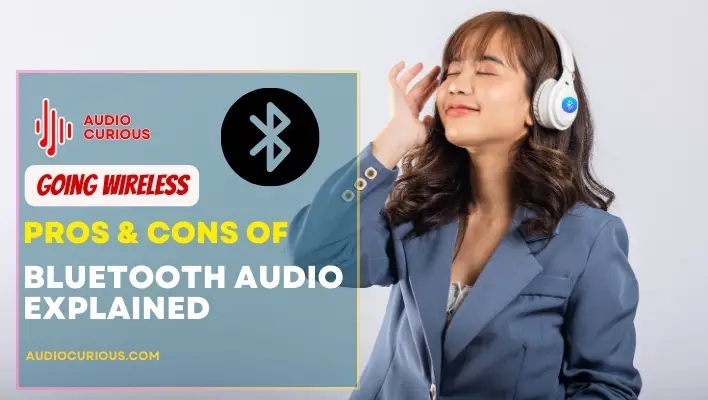Bluetooth technology has come a really long way since its humble beginnings as a low-bandwidth solution for transmitting audio wirelessly from a cell phone to a headset. Today, Bluetooth has transcended its initial purpose and has grown into a versatile and widely adopted standard for wireless communication.
Bluetooth audio allows wireless transmission of audio signals between devices. Instead of using traditional wired connections, it enables devices such as smartphones, laptops, headphones, and speakers to communicate with each other through short-range radio waves.
So, if you’re curious about why everyone’s ditching the wires and embracing Bluetooth audio, stick around. We’re about to discuss the pros and cons of this tech and highlight why it’s making our music and audio experience so much better!
How Bluetooth Works
Bluetooth is a wireless communication that uses radio frequency waves to communicate within the 2.4 GHz ISM band. Bluetooth technology uses a technique called frequency hopping to avoid interference from other wireless devices operating in the same frequency range. It achieves this by dividing the 2.4 GHz band into multiple channels and rapidly switches between them (hopping). This helps reduce the chances of signal interference and improves overall reliability.
A Bluetooth network is called a piconet, which consists of two or more devices connected in an ad-hoc manner. One device acts as the master, while others act as slaves. The master coordinates communication within the piconet.
Before devices can communicate, they need to be paired. This is a one-time setup where the devices establish a connection and remember each other for future use. During pairing, devices exchange security keys to establish a secure connection.
Pairing can be done using a PIN code, a passkey, or in some cases, without any user intervention (automatic pairing). Once paired, audio signals are transmitted wirelessly between the connected devices. For example, you can play music from your smartphone and have it sent wirelessly to your Bluetooth headphones or speakers.
To ensure compatibility between different devices, Bluetooth uses a set of standardized protocols called profiles. Profiles define the specific features and functionalities that devices can support. Examples include the Hands-Free Profile (HFP) for hands-free communication in cars and the Advanced Audio Distribution Profile (A2DP) for high-quality audio streaming.
Many modern devices feature Bluetooth as a standard, ensuring widespread compatibility across various brands and models. The universal compatibility has contributed to the widespread adoption of Bluetooth audio technology.

Audio Quality and Compression
Bluetooth audio quality is determined by the compression of audio data during transmission. Bluetooth uses various audio codecs to compress the original audio signal into a more manageable form for transmission and then decompress it to its original form upon reception.
SBC is the default codec for Bluetooth audio and is widely supported across devices. It offers relatively low complexity, making it compatible with a broad range of hardware. However, SBC has a lower audio quality compared to more advanced codecs.
AAC is a higher-quality Bluetooth codec commonly associated with Apple devices. It provides better audio compression than SBC, resulting in improved sound quality, especially at lower bit rates. AAC is also widely supported on various Bluetooth-enabled devices.
AptX is a proprietary audio codec designed for the transmission of high-quality audio over Bluetooth connections. This codec aims to deliver near-CD quality sound wirelessly using more efficient compression algorithm that retains more of the original audio data.
AptX HD is an enhanced version of the standard AptX codec, designed to support high-definition audio. It allows for the transmission of 24-bit audio at a higher bit rate, catering to audiophiles and those seeking a more immersive listening experience.
On the other hand, Sony’s LDAC is designed to transmit high-resolution audio over Bluetooth. With a focus on superior sound quality, LDAC supports higher bit rates, which facilitates seamless streaming of high-fidelity music over Bluetooth connections. LDAC is tailored for audiophiles and those seeking an immersive audio experience.
When it comes to audio quality, the choice of codec is crucial, but it’s also essential to consider the compatibility of the codec across devices. Both the transmitting and receiving devices need to support the same codec for optimal performance. Additionally, the available bandwidth and signal strength can affect the performance of these codecs, which can impact the overall audio experience.

Bluetooth Compatibility and Range
Bluetooth compatibility and range are essential considerations in understanding the capabilities and limitations of communication between devices. Bluetooth compatibility refers to the ability of devices to work together and communicate over a Bluetooth connection.
Bluetooth technology evolves with different versions, each introducing improvements. Ideally, compatibility between devices depends on their Bluetooth versions. For example, Bluetooth 5.0 devices are backward compatible with older versions, but you might not benefit from the latest features unless both devices support the same version.
Bluetooth devices primarily use profiles to define their capabilities and functionalities. Common profiles include A2DP (for stereo audio streaming), HFP (for hands-free calling), and HID (for input devices). For seamless interaction, devices must support the relevant profiles.
And as we’ve mentioned, Audio codecs play a crucial role in determining sound quality during Bluetooth transmission. To enjoy high-quality audio, both the sending and receiving devices must support the same Bluetooth codec.
Bluetooth technology is designed to be interoperable, meaning that devices from different manufacturers can generally communicate with each other. However, differences in implementations, firmware, and support for specific features may lead to variations in user experience.
On the other hand, Bluetooth range specifies the maximum distance over which Bluetooth-enabled devices can establish and maintain a reliable wireless connection. Bluetooth devices are mainly categorized into different classes based on their power levels.
Class 1 devices have a longer range compared to Class 2 and Class 3 devices. For example, Class 1 devices can have a range of around 100 meters, while Class 2 devices have a range of about 10 meters. On the other hand, Class 3 devices (low power) usually have a range of less than 1 meter.
Physical obstructions like walls and interference from other electronic devices can reduce Bluetooth range. In an open space, devices may achieve their maximum range, but obstacles can significantly affect the signal strength.
In some scenarios, Bluetooth devices can form mesh networks where multiple devices work together to relay data over longer distances. This is especially useful in smart home applications where devices are distributed throughout a larger area.
The actual range experienced can vary depending on the signal strength of the transmitting and receiving devices. Factors like the battery level of devices, antenna design, and power management can influence signal strength and, consequently, the effective range.
In addition, newer Bluetooth versions, such as Bluetooth 5.0 and beyond, may offer improvements in range compared to older versions. However, for you to realize these improvements, both the transmitting and receiving devices must support the same Bluetooth version.

Advantages of Bluetooth Audio
Wireless Convenience
Bluetooth eliminates the need for physical cables between devices, which provides users with a wireless and clutter-free experience. This is particularly advantageous for portable devices like smartphones, headphones, and speakers.
Universal Compatibility
Bluetooth is a widely adopted standard across various devices and manufacturers. Most smartphones, tablets, laptops, audio peripherals, and automotive systems support Bluetooth connectivity, ensuring broad compatibility.
Ease of Use
Pairing Bluetooth devices is typically straightforward and user-friendly. The process usually involves selecting the devices from the Bluetooth menu and confirming the connection. Many devices also support quick pairing methods, making the setup process even more convenient.
Versatility
Bluetooth supports a variety of audio profiles and codecs, which allows it to handle different types of audio content. Whether it’s music, phone calls, or multimedia, Bluetooth can accommodate a range of audio applications.
Portability
One of the selling point of Bluetooth-enabled audio devices is enhanced portability. Users can enjoy their favorite music or take calls without being tethered to their devices.
Continued Development
Bluetooth technology continually evolves with new versions and enhancements. Each iteration brings improvements in terms of data transfer speed, range, power efficiency, and audio quality. This ensures that Bluetooth remains a relevant and capable wireless technology.
Low Power Consumption
Bluetooth technology is designed to be energy-efficient, making it suitable for battery-powered devices like wireless headphones or earbuds. Bluetooth Low Energy (LE) variants further optimize power consumption, which extends battery life.
Cost-Effective
Bluetooth is a cost-effective solution for wireless audio connectivity. The technology is widely available, and its implementation in devices does not significantly increase manufacturing costs.
Seamless Integration with Smart Devices
Bluetooth seamlessly integrates with smart devices and the Internet of Things (IoT). Smart homes, wearable devices, and other connected ecosystems often use Bluetooth for audio communication and control.
Disadvantages of Bluetooth Audio
Loss of Audio Quality
Bluetooth audio may experience some loss in audio quality due to compression during data transmission. Audiophiles who prioritize the highest audio fidelity may notice this difference, especially when streaming high-resolution audio.
Latency
Bluetooth audio can introduce latency, resulting in a slight delay between the audio source and the output on connected devices. This latency may be noticeable during activities like gaming or when watching videos.
Limited Range
The effective range of Bluetooth is generally shorter than some other wireless technologies. While Bluetooth Class 1 devices can achieve longer ranges, most consumer devices fall into Class 2, limiting the distance between connected devices to around 10 meters (30 feet).
Interference
Bluetooth operates in the 2.4 GHz frequency band, which is shared with various other wireless technologies like Wi-Fi. Interference from these devices can impact Bluetooth performance, leading to signal drops or reduced range.
Device Compatibility
While Bluetooth is a widely adopted standard, not all devices may support the same Bluetooth versions or profiles. Compatibility issues can arise, particularly when trying to connect older devices with newer ones or when using different Bluetooth audio codecs.
Battery Consumption
Constant wireless communication can contribute to increased power consumption on both the transmitting and receiving devices. This can be a concern for battery-powered devices like headphones.
Pairing and Connectivity Issues
Some users may experience difficulties when pairing Bluetooth devices or maintaining a stable connection. This can be due to interference, software glitches, or limitations in device compatibility.
Device Dependency
The quality of the Bluetooth audio experience may vary between devices and manufacturers. Differences in Bluetooth chipsets, codec support, and implementation can impact the overall performance.
Parting Shot!
Overall, Bluetooth audio provides a versatile and user-friendly solution for wireless audio communication, catering to a broad range of devices and user preferences. And despite its limitations, Bluetooth audio remains a widely used and convenient technology for wireless audio communication. Many listeners find that the benefits outweigh the drawbacks, especially for everyday use and casual listening.
